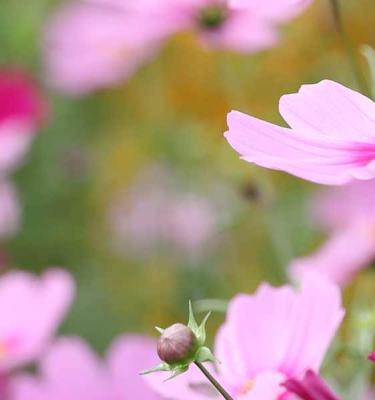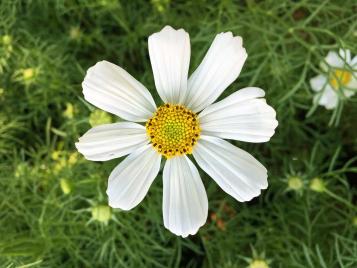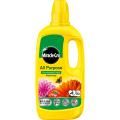

How To Sow, Grow and Care For Cosmos in 8 Simple Steps
Cosmos, also known as ‘Mexican Aster’, is a great low maintenance and long flowering annual. The name Cosmos, originates from the Greek word for beautiful, referencing their pretty flowers. Cosmos bedding plants are a popular purchase due to their range of colours from white through to orange, pink and chocolate. White Cosmos flowers, named ‘Purity’, have seen a boost recently due to a rise in people choosing to create an all-white garden.
When do Cosmos flower?
No matter whether you have a large garden, a small garden or a few pots on a patio, Cosmos are a wonderful cut-and-come-again flower that provides colour and soft feathery light green foliage from July through to October in the UK.
Types of Cosmos plants to grow
Interestingly there are more than 20 varieties of Cosmos plants, but the most common variety to the UK gardener is the annual Cosmos bipinnatus. The lesser known variety in the UK is Cosmos sulphureus or yellow Cosmos.
Cosmos bipinnatus are the bushier variety of plant and grow up to 1.2m tall. The flower colours range from red, pink and white. Cosmos sulphureus are taller, growing up to a heady 1.8 m and the flowers are either orange, yellow or red.

Full height Cosmos look best grown in profusion towards the back of the bed, allowing their soft feathery foliage and multiple flower heads to seamlessly blend together, giving a swather of colour and movement.
Dwarf Cosmos varieties work best in pots as their smaller size is more manageable for container gardening.
Although we more commonly know Cosmos as being an annual plant, there is of course an exception to the rule. Cosmos atrosanguineus or chocolate Cosmos flower is a tender perennial, meaning that its tubers should be lifted in the autumn and kept in a dry shed over winter or protected from the frost and cold weather by covering with straw, mulch or wrapped in horticultural fleece. Although dark in colour, the reference to chocolate is for its rich cocoa fragrance.
Whether you are growing full size, dwarf, annual or perennial Cosmos, they work well in an informal garden setting, for example, cottage, wildflower or prairie style.
Cosmos flowers are open and flat in appearance meaning their nectar is easy for all pollinators to access. Another reason that Cosmos plants are a wonderful addition to your garden.
What you’ll need to grow Cosmos
Cosmos plants originated in Mexico and South America, hence they flourish in sheltered and full sun positions. They can thrive in relatively poor soil, but they do need watering and flower best in good quality well-drained soil.
Cosmos is a forgiving and an easy to grow annual, perfect for seasoned and keen beginners alike to grow. Just make sure you plant out Cosmos after the risk of frosts and cold weather has passed, usually around mid-May.
To grow Cosmos from seed, you will need:
- Covered seed trays - depending on the size of your garden and space for planting Cosmos, you don’t need to sew all seeds in one season.
- Seed compost - try to use peat-free compost. As seeds contain all the energy they need to grow in the first instance, seed compost is lower quality than ‘potting on’ or a multi-purpose compost.
- Watering can for light watering in seed trays.
- Liquid seaweed feed - particularly for container gardening.
- Canes and twine - make sure you have some canes/sticks available for staking. When Cosmos grow to their full height, they may well need some support.
Where to plant and place your Cosmos
Growing Cosmos in covered seed trays and wondering when to plant the seeds? Follow these four easy steps on how to successfully sow Cosmos seeds on a sunny windowsill or greenhouse and enjoy months of flowers in your garden or in a vase.
- In March or April, scatter the Cosmos seeds thinly in a seed tray filled with good quality peat-free seed compost. They can be tricky to handle as they are long thin seeds.
- Cover with a light layer (approx 3mm) of compost and put on a warm windowsill or in a greenhouse to germinate. Water sparingly but regularly.
- Once germinated and big enough to handle, carefully pot on. To encourage a bushier and sturdier plant, once you have three sets of leaves below the tip, pinch out the top pair of leaves. Pinching out not only encourages a bushier plant, but also encourages more flowers.
- Pot on the Cosmos seedlings into slightly larger pots once they are fuller and big enough to handle (approx 8 - 10 cm tall). Use potting on peat-free compost.
- When the risk of frosts has finished, around late May plant out Cosmos in a sunny position towards the back of your bed.
When to plant Cosmos seeds
If growing Cosmos from seed in seed trays on a windowsill or greenhouse, plant Cosmos seeds around March/April time. Don’t plant before then as they can only be planted outside after the risk of frosts have finished in mid/late May. Cosmos will grow too leggy inside if planted in seed trays before March/April. If you are planting Cosmos seeds directly in the ground, scatter seed on finely raked good quality soil in late May. Not only has the risk of frosts finished, but the soil has had the opportunity to warm through, making germination easier.
How to sow Cosmos seeds directly in the ground
- Best done in May/June by scattering seeds evenly in raked soil and covering lightly. Cosmos seeds should be scattered in their final growing position.
- Water well.
- Keep your eye on their germination and pinch out the top buds as described above.
Cosmos take between seven and 21 days to germinate.
Once Cosmos have finished flowering, their seed heads can be left on to allow for self-seeding for the following year. If you don’t want any Cosmos growing the following year, remove all plants by the root before the seed head appears in the early autumn.
If you’d rather buy Cosmos plug plants, or garden ready plants, garden centres and online garden supply shops should have them ready around mid-May onwards.
Caring and nurturing your Cosmos
For the perfect cosmos plant care, once you have potted on your seedlings into slightly larger pots, harden them off by putting them outside on warmer days and bringing them in at night. As with many annuals, as they grow, flower and die all in one season, feeding helps give them boosted energy to produce as many flowers as possible. Feed fortnightly using either homemade compost from a compost/worm bin or liquid seaweed feed.
If you notice your Cosmos are growing leggy without any flowers, stop feeding and monitor their growth and flower production.
During the growing and flowering season, ensure they are watered regularly if there is no rainfall.
The full-size Cosmos varieties will most likely need staking as they can reach up to 2.5m in their preferred full sun position. Stake using a cane or other slender garden stick that is tall enough to take on the highest Cosmos. Use string or a lightweight tie to loop the stalks together. You may need to do several loops of string around the canes when the plants are at their full height to capture all the stalks together.
No pruning is needed, but deadheading or regular picking ensures a bountiful crop of repeat flowers for up to four months into early autumn, or before the first frosts.
Common pests and diseases with Cosmos
Are earwigs and aphids a problem for Cosmos?
Cosmos may be susceptible to earwigs and aphids but as the earwigs eat the aphids, it’s worth sticking with the earwigs, if you can, as a natural pest control.
Will slugs eat my Cosmos plants?
As with most tender seedlings, slugs are common cosmos flower pests. Use a slug barrier as and when needed to prevent damage.
What is the grey on the leaves of my Cosmos plants?
If the weather is particularly humid, Cosmos may be susceptible to grey mould or mildew. Remove affected discoloured leaves and if necessary, plants too. This helps to avoid re-infection and to create more airflow.
Why do my Cosmos plants have yellowing leaves?
As Cosmos is a member of the Aster family, they can suffer from a disease called Aster Yellows that is spread by a tiny insect called a leafhopper. The most obvious sign of this disease is yellow mottling leaves and malformed flowers.
If you spot both these signs, the best thing to do is take out the plants from the root and destroy them.
Frequently asked questions about Cosmos
Do Cosmos come back every year?
Lots of people ask whether Cosmos is a perennial, as it’s a little confusing. In the first instance, if the seed heads are left on (the annual varieties), they will set seed and you should have a flurry of new plants for next year. If you have chosen to grow the perennial version (Chocolate Cosmos), you should cut back the stems to approx 5 cm above the ground in the autumn and then protect them with straw, mulch or horticultural fleece over the winter. If grown in pots, then move to a protected spot or greenhouse.
Will Cosmos grow in partial shade?
Cosmos prefer to grow in a full sun position. If grown in partial shade, there is the possibility that the plants will grow leggy with little or no flowers as they stretch out to find the light.
Can you grow Cosmos in pots?
Yes, Cosmos can be grown in pots and garden containers. When sowing Cosmos seeds to grow in containers or buying plants, make sure to choose a dwarf Cosmos, which is better suited to growing in pots. Pots and containers for Cosmos should be around 30 cm or larger in diameter.
As with all container gardening, your pots should have adequate drainage. Use a good quality peat-free compost and feed the fully grown Cosmos fortnightly, ideally with homemade compost or liquid Seaweed feed. Or if you prefer, a slow-release feed should last their growing season.
Place pots in a sunny sheltered position to maximise flowering.
Key features of Cosmos
| Botanical Name | Cosmos |
|---|---|
| Plant Type | Half-hardy annual |
| Family | Asteraceae |
| Light Exposure | Full sun |
| Soil pH | Neutral |
| Flowering Time | July to October |
| Flower Colour | Various from white through to pinks, reds and purples. All colours have a yellow centre |




